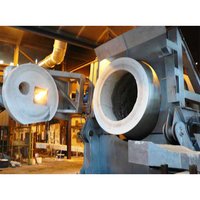



TRF Furnace
1000000 INR/Unit
Product Details:
- Condition New
- Size 500 Kg
- Usage Melting Furnace
- Voltage 410 Volt (v)
- Application Industrial
- Click to view more
X
TRF Furnace Price And Quantity
- 1000000 INR/Unit
- 1 Unit
- 1000000.00 - 2000000.00 INR/Unit
TRF Furnace Product Specifications
- 500 Kg
- Industrial
- New
- 410 Volt (v)
- Melting Furnace
TRF Furnace Trade Information
- JNPT Port
- Letter of Credit (L/C), Letter of Credit at Sight (Sight L/C), Telegraphic Transfer (T/T), Cheque
- 10 Unit Per Month
- 4 Week
- Middle East, Central America, Eastern Europe, South America, Asia, Western Europe, North America, Australia, Africa
- All India
Product Description
To meet the diversified requirements of our prestigious clients, we are occupied in offering industrial Tilting Rotary Furnace (TRF Furnace) that is used generally used in metallurgical and mining processes. This product is demanded for its properties like high operational fluency, low energy consumption, optimal performance, negligible maintenance and longer working life. Manufactured by a team of seasoned professionals using quality tested components in our advanced production unit, this product is checked on different stringent parameters for its functionality and quality by our quality controllers.
TRF Furnace Applications:
Steel Production: TRF furnaces are widely used for steel production, particularly for producing specialty steels with specific properties such as high strength, corrosion resistance, or heat resistance.
Stainless Steel Production: TRF furnaces are commonly employed in the production of stainless steel, which requires precise control over the composition of alloying elements like chromium and nickel.
Alloy Steel Production: TRF furnaces are suitable for producing alloy steels by adding various alloying elements such as manganese, molybdenum, and vanadium to the molten metal.
Carbon Steel Production: TRF furnaces are also used for producing carbon steel, which is the most common type of steel used in various industries due to its affordability and versatility.
Refining Processes: TRF furnaces play a crucial role in refining processes such as desulfurization, dephosphorization, and degassing, where impurities are removed from the molten metal to improve its quality.
Continuous Casting: In some cases, TRF furnaces are integrated into continuous casting processes, where molten steel is directly cast into semi-finished products like billets, blooms, or slabs without the need for ingot casting.
Recycling: TRF furnaces can also be used in steel recycling plants to melt down scrap steel and other metallic materials, which are then refined and reused in the production of new steel products.
Heat Treatment: TRF furnaces may also be utilized in heat treatment processes such as annealing, quenching, and tempering to modify the mechanical properties of steel according to specific requirements.
TRF Furnace FAQ:
What is a TRF furnace?
A TRF furnace is a type of metallurgical furnace used for steelmaking. It features a lance that is submerged into the molten metal, allowing for precise control over temperature and composition during the steelmaking process.
How does a TRF furnace work?
In a TRF furnace, oxygen or other gases are injected through the submerged lance into the molten metal bath. This promotes the oxidation of impurities and the removal of unwanted elements, resulting in refined steel with desired properties.
What are the advantages of a TRF furnace?
TRF furnaces offer several advantages, including high efficiency, precise control over the steelmaking process, flexibility in adjusting composition and temperature, and the ability to produce high-quality steel with minimal impurities.
What types of steel can be produced in a TRF furnace?
TRF furnaces can be used to produce various types of steel, including carbon steel, stainless steel, alloy steel, and specialty steels with specific properties such as high strength, corrosion resistance, or heat resistance.
What is the difference between a TRF furnace and other types of steelmaking furnaces?
The main difference between a TRF furnace and other types of steelmaking furnaces lies in the method of injecting gases into the molten metal. In a TRF furnace, gases are injected through a submerged lance, whereas in other furnaces, such as basic oxygen furnaces (BOF) or electric arc furnaces (EAF), gases are injected from above the metal bath.
What are some common applications of TRF furnaces?
Common applications of TRF furnaces include steel production, stainless steel production, alloy steel production, refining processes (e.g., desulfurization, dephosphorization, degassing), continuous casting, steel recycling, and heat treatment.
How is the operation of a TRF furnace monitored and controlled?
TRF furnaces are equipped with advanced control systems that monitor various parameters such as temperature, composition, gas flow rates, lance position, and energy consumption. These systems enable operators to maintain optimal conditions for steelmaking and make adjustments as needed.
What are some environmental considerations associated with TRF furnaces?
TRF furnaces, like other steelmaking processes, can generate emissions and waste products that need to be managed properly to minimize environmental impact. Efforts are often made to optimize energy efficiency, reduce emissions of greenhouse gases and pollutants, and recycle waste materials wherever possible.
FAQs of TRF Furnace:
Q: What is the size of TRF Furnace?
A: The size of TRF Furnace is 500 Kg.Q: What is the application of TRF Furnace?
A: The application of TRF Furnace is industrial.Q: What is the usage of TRF Furnace?
A: The usage of TRF Furnace is as a melting furnace.Q: What is the condition of TRF Furnace?
A: The condition of TRF Furnace is new.Q: What is the voltage requirement for TRF Furnace?
A: The voltage requirement for TRF Furnace is 410 Volt (v).Tell us about your requirement

Price:
Quantity
Select Unit
- 50
- 100
- 200
- 250
- 500
- 1000+
Additional detail
Mobile number
Email
Other Products in 'Melting Furnace' category


 English
English Spanish
Spanish French
French German
German Italian
Italian Chinese (Simplified)
Chinese (Simplified) Japanese
Japanese Korean
Korean Arabic
Arabic Portuguese
Portuguese






 Send Inquiry
Send Inquiry Send SMS
Send SMS Call Me Free
Call Me Free
